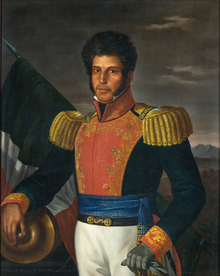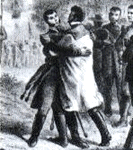Discontent over Spanish rule was spreading throughout New Spain at the beginning of the 19th century. While many remained loyal royalists, the seeds of revolution were spreading through the wealthy nobility, as well as through slaves and the economically disenfranchised. When Napoleon invaded Spain causing King Carlos to abdicate, the time seemed ripe for Mexico to throw off the yoke of colonialism, like the United States had done a few decades earlier. Independence would take a full decade to achieve, through blood spilled on the battlefield, and blood spilled in political assassination. It all began with a cry for freedom in the town of Dolores, Guanajuato....
| Mexico historical travel topics: Mesoamerica → Colonial Mexico → Mexican War of Independence → Post-Independence Mexico → Mexican Revolution → Modern Mexico |
Cry of Dolores
edit
The first act of rebellion against the Spanish crown came when Father Miguel Hidalgo y Costilla issued his famous "Grito de Hidalgo" in front of parishioners on September 16, 1810 at his church in the town of Dolores, Guanajuato. Hidalgo incited the people to revolt against Spanish rule. His speech is usually paraphrased as "Long live Our Lady of Guadalupe! Long live Mexico! Death to bad government! Death to Spaniards!" Whatever his exact words, they were enough to get everyone fired up and ready to march on the royalists.
Hidalgo's "Grito" wasn't an impulse. He had been meeting with others who shared his views, often under the guise of a literary club that was hosted by the mayor of Queretaro's wife. You can learn more about these precursors to revolution by visiting the Casa de la Corregidora in Queretaro.
Unfortunately for Hidalgo, he had lots of experience as a priest but precious none as a soldier, and it wasn't long before his fast-growing crowd of merchants and peasants faced off against trained royalist troops. Hidalgo's army (which included several military officers, such as Ignacio Allende and Juan Aldama) marched on Guanajuato where they attacked the Grain Exchange (Alhóndiga de Granaditas), killing over 300 soldiers and Spanish loyalists.
Marches and battles elsewhere ensued as the growing army headed toward Mexico City. Many of his followers were killed and Hidalgo himself was captured. The church defrocked him, the government executed along with several of his followers, and their decapitated heads were strung up along the Alhondiga de Granaditas as a macabre warning to anyone else who might think of treason.
But the people remembered Hidalgo and his followers carried on. Today, Hidalgo is acknowledged as the father of his country and his spirit is remembered every year on Independence Day when the President of Mexico steps out on the balcony of the Palacio Nacional, rings Hidalgo's church bell and yells, "Viva México! Viva la Independencia! Vivan los héroes!" It's like fireworks on the 4th of July...errr, 16th of September.
Destinations
edit- 1 Parroquia de Nuestra Señora de Dolores, Dolores Hidalgo. Parish church of Father Miguel Hidalgo where he issued his nation-shattering "Grito de Dolores". While you're in town, be sure to visit Hidalgo's home (burned by the royalists, reconstructed after the revolution and dedicated by Emperor Maximilian) as well as the nearby Museo de la Independencia and the Monument to Hidalgo. The good padre is kind of well known around these parts.
- 2 Casa de la Corregidora, C. 5 de Mayo, Centro Queretaro. Historical home of Queretaro's mayor and his wife, Josefa Ortiz de Domínguez, who hosted an intellectual secret society that included patriots like Miguel Hidalgo, Jose Maria Morelos, and Ignacio Allende as they talked about their hopes and dreams for independence from Spain. Free historical tours are available.
- 3 Alhóndiga de Granaditas, C. Mendizábal 6, Centro Guanajuato. First and last target of Miguel Hidalgo. The revolutionaries killed many royalists, but Hidalgo and several of his key followers were apprehended and executed. The museum contains quite a bit of displays about the War for Independence as well as a large art collection. Hidalgo's head no longer hangs off the ramparts.
- 4 Museo de la Independencia Nacional, Dolores Hidalgo. Large museum chronicling Mexico's War of Independence, from Father Hidalgo's first cry for independence, through the embrace between Agustin Iturbide of the royalists and Vicente Guerrero of the insurgents. Many exhibits, relics, and multimedia presentations.
Morelos wages War
edit
From 1811 to 1815 the revolutionary army was under the leadership of Jose Maria Morelos, another parish priest forced by circumstances to become a soldier. He wasn't alone, Mariano Matamoros was a priest from Mexico City who caught Morelos's eye because of his charismatic leadership. Matamoros was quickly promoted to colonel, then to lieutenant general, though he would fall in battle in 1814. Morelos was also blessed with a fair number of commanders with military experience: Vicente Guerrero, Guadalupe Victoria, and Ignacio López Rayón among them.
Morelos conducted wide ranging attacks on royalist forces throughout Central Mexico, including occupations of quite a few towns that are today popular destinations or day trips for travelers and foreign visitors. Some places where you are likely to find monuments or museums describing battles during the War of Independence include:

- Acapulco
- Chilpancingo
- Cuautla
- Tenancingo
- Taxco
- Tehuacán
- Orizaba
- Puebla
- Oaxaca (Acatempan)
Destinations
edit- 5 Museo Casa de Natal de Morelos (Birthplace of Morelos), C. la Corregidora 113 Morelia. The town used to be called Vallodolid, but once he led the charge for independence, Morelos was the town's favorite son, so they renamed the whole town in his honor. This well restored neoclassical home is where he was born and raised. Several war relics and personal possessions are displayed here along with exhibits that explain events of Mexico's war for indpendence and Morelos's role in them. A larger range of historical exhibits and a full historical library with archives are about a block away at Av. J. Ma. Morelos sur 323.
Guerrilla warfare under Guerrero
edit
By 1815, the royalists assumed they had put down the insurrection. All of Mexico's key cities were under royalist control. Morelos and several of his key military leaders had been captured and executed, and an amnesty was issued for the insurgents. But the insurgency lived on under the leadership of Guadalupe Victoria and Vicente Guerrero. The insurgency would fight on until 1820.
Given the superiority of royalist forces and their control of major cities, the insurgents retreated to more rural areas in southern Mexico, where they employed guerrilla tactics. Hit-and-run strikes on royalist military units became commonplace.
By 1820, King Ferdinand VII was facing troubles at home, where his military leadership turned on him in a coup. The military didn't necessarily want a new king, but they didn't like an all-powerful king. They wanted a constitutional monarchy that placed limits on the king's power and that had some social protections for the working classes. Ferdinand would keep his crown, but the dynamics of his relationship with New Spain had changed. By this time, the crown was also missing their payroll commitments to the royalist troops who weren't too happy about being shot at and not even getting paid for taking the risk. Troop morale was low.
In what would become the final campaign of the War of Independence, Colonel Iturbide led the royalist forces towards Oaxaca on the trail of Vicente Guerrero and his insurgent army.
Destinations
editPlan de Iguala
editBoth Iturbide and Guerrero were in tough positions by the time they met near Oaxaca. Iturbide realized the futility of fighting for the Spanish crown to retain control of New Spain, and his troops were increasingly unhappy and unwilling to fight. Guerrero was worried that the wealthy landholders would also abandon loyalty to the crown and create a new government that excluded indigenous and other lower classes. For Guerrero, equality for all was of tantamount importance.

Iturbide sent and emissary to Guerrero to discuss how they could end the war and create a new constitution for a new Mexico. Iturbide proposed using the new Spanish constitution as a model, but Guerrero rejected it because it excluded Africans from enjoying the rights of citizenship. Iturbide and Guerrero met at Acatempan (outside Oaxaca) where they talked, resolved their differences, and produced a document called the Plan de Iguala that laid out the foundation for a new Mexico, based on 3 fundamental guarantees: 1) the government would be an independent constitutional monarchy (i.e., there would be a king of Mexico), 2) catholicism would be the official religion, and 3) all racial groups would be considered equal with no privileges afforded to any group. Iturbide presented the plan to his troops, who accepted it, and Guerrero presented the plan to the insurgents, who united with Iturbide's troops to form a new "army of the three guarantees". They adopted a new flag with the colors red, white, and green to represent the three guarantees.
There was initial dissent on both sides, but over the next year, most royalists favored ending Spanish control and most insurgents abandoned their fight. The War of Independence officially ended when the Spanish viceroy signed the Treaty of Cordoba. Although the plan was to bring in a European monarch to serve as the king of Mexico, Iturbide had added a clause to the treaty that a criollo (born in Mexico) could be appointed monarch if no suitable European was found. The next year, Iturbide managed to be named that criollo monarch and was crowned Agustin I, Emperor of Mexico.
Destinations
edit- 7 Angel of Independence, Reforma, Mexico City. Visitors to Mexico City can't miss the Angel of Independence — the golden winged angel high atop a marble pylon in the middle of the city's most illustrious thoroughfare, but few foreigners know its significance. This is one of the most important monuments in the country because it commemorates the nation's independence and is the final resting spot for several heroes of independence, including Miguel Hidalgo, Jose Maria Morelos, and Vicente Guerrero.
